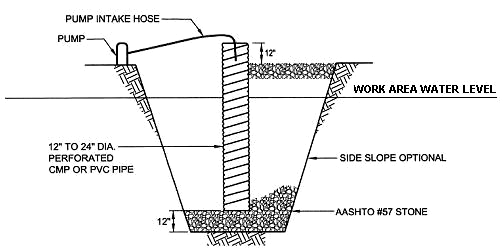Sump Pit

Definition
A temporary pit which is constructed to trap and filter water for pumping into a suitable discharge area. A perforated vertical standpipe is placed in the center of the pit to collect filtered water. The purpose of this practice is to remove excessive water in a manner that improves the quality of the water.
Where Practice Applies
Sump pits are constructed when water collects during the excavation phase of construction. This practice is particularly useful in urban areas during excavation for building foundations.
Planning Considerations
- Discharge of water pumped from the standpipe should be to a suitable practice such as a sediment basin, sediment trap, or a stabilized area.
- If water from the sump pit will be pumped directly to a storm drainage system, geotextile filter fabric should be wrapped around the standpipe to ensure clean water discharge. It is recommended that 1⁄4 to 1⁄2 inch mesh hardware cloth wire be wrapped around and secured to the standpipe prior to attaching the filter fabric. This will increase the rate of water seepage into the standpipe.
Design Recommendations
A perforated vertical standpipe is placed in the center of the pit to collect filtered water. The standpipe will be a perforated 12 to 24-inch diameter corrugated metal or PVC plastic pipe. Water is then pumped from the pit to a suitable discharge area. The pit will be filled with coarse aggregate.
Maintenance
- The sump pit will become clogged with sediment, oils, and organic matter over time. It is important to remove grass clippings and leaves from the surface of the aggregate in order to prolong its life.
- The pit should be checked after every major storm to evaluate its effectiveness. If the pit and filter fabric become plugged with sediment, the pit should be rehabilitated. In some cases complete removal and replacement of the entire dry well may be necessary.
References
U.S. Department of Agriculture, Natural Resources Conservation Service, Champaign, IL, Urban Conservation Practice Standards, 1994